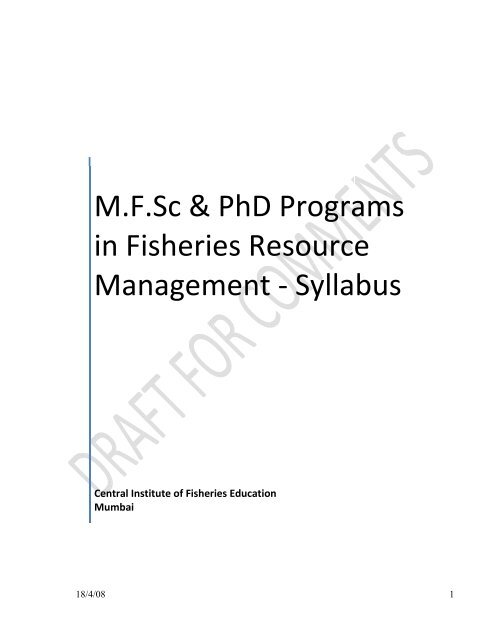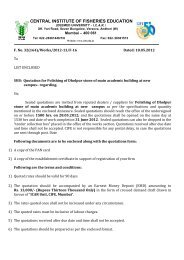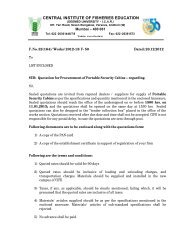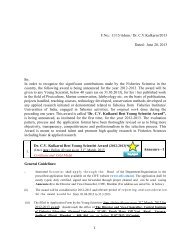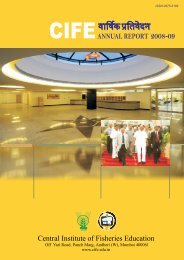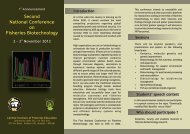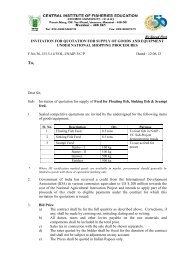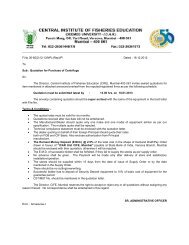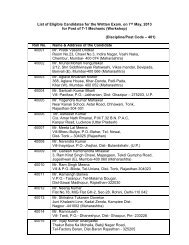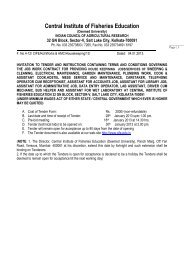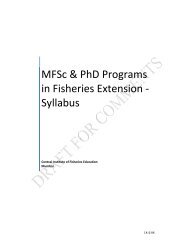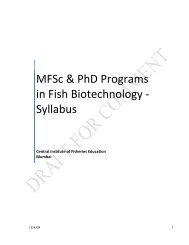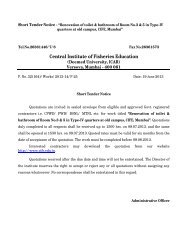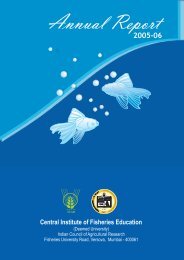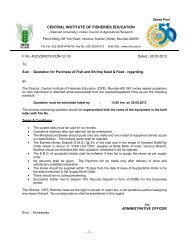Fisheries Resource Management MFSc & PhD Syllabus
Fisheries Resource Management MFSc & PhD Syllabus
Fisheries Resource Management MFSc & PhD Syllabus
You also want an ePaper? Increase the reach of your titles
YUMPU automatically turns print PDFs into web optimized ePapers that Google loves.
M.F.Sc & <strong>PhD</strong> Programs<br />
in <strong>Fisheries</strong> <strong>Resource</strong><br />
<strong>Management</strong> - <strong>Syllabus</strong><br />
Central Institute of <strong>Fisheries</strong> Education<br />
Mumbai<br />
18/4/08 1
M.F.Sc. (<strong>Fisheries</strong> <strong>Resource</strong> <strong>Management</strong>) Major Courses<br />
Code Course Title Credits<br />
CORE COURSES<br />
1. FRM 501 Inland <strong>Fisheries</strong> <strong>Resource</strong>s 2+1<br />
2. FRM 501 Marine <strong>Fisheries</strong> <strong>Resource</strong> <strong>Management</strong> 2+1<br />
3. FRM 503 Marine Ecosystems, Biodiversity and Conservation 2+1<br />
4. FRM 504 Tropical Fish Stock Assessment 2+1<br />
OPTIONAL COURSES<br />
1. FRM 505 <strong>Fisheries</strong> Regulations 2+1<br />
2. FRM 506 Remote Sensing and GIS for <strong>Fisheries</strong> <strong>Management</strong> 1+1<br />
3. FRM 507 Coastal <strong>Resource</strong> <strong>Management</strong> 2+1<br />
4. FRM 508 Aquatic Floral <strong>Resource</strong>s 2+1<br />
5.<br />
FRM 509<br />
Feeding and Reproductive Biology of Finfish and<br />
Shellfish<br />
2+1<br />
6. FRM 510 Developmental Biology of Finfish and Shellfish 2+1<br />
7. FRM 511 Fishing and Allied Technologies 2+1<br />
8. FRM 512 Modern techniques in Ichthyotaxonomy 2+1<br />
<strong>PhD</strong> (<strong>Fisheries</strong> <strong>Resource</strong> <strong>Management</strong>) Major Courses<br />
Code Course Title Credits<br />
CORE COURSES<br />
1. FRM 701 Assessment of Aquatic Biodiversity 2+1<br />
2. FRM 702 Applications of <strong>Fisheries</strong> Models in Stock Assessment 2+1<br />
3. FRM 703 Conservation and <strong>Management</strong> of Exploited <strong>Fisheries</strong><br />
<strong>Resource</strong>s<br />
OPTIONAL COURSES<br />
1. FRM 707 Coral Reef <strong>Management</strong> 2+1<br />
2. FRM 708 Data Collection and Estimation of Exploited <strong>Fisheries</strong><br />
<strong>Resource</strong>s<br />
0+2<br />
3. FRM 709 <strong>Fisheries</strong> Environmental Assessment 2+1<br />
4. FRM 711 Issues in Capture <strong>Fisheries</strong> 1+1<br />
18/4/08 2<br />
2+1
CORE COURSES<br />
1. FRM 501 Inland <strong>Fisheries</strong> <strong>Resource</strong>s (2+1)<br />
Objectives:<br />
The course will be of use to know the present exploitation and future potential of inland<br />
<strong>Fisheries</strong><br />
The students will be exposed in learning the methodologies for assessments of Inland <strong>Fisheries</strong><br />
<strong>Resource</strong>s<br />
Theory<br />
Categorization of different freshwater fisheries resources: Ponds, lakes, bheels, tanks, estuaries,<br />
brackish water lagoons, wetlands, biosphere reserves and mangroves and derelict water bodies,<br />
their problems and management aspects.<br />
Bheel fisheries resources of India: Open and closed bheels, productivity conditions, capture<br />
scenario, prospects of culture based systems.<br />
Riverine fisheries resources: Present trend of dwindling fisheries resources, direct and indirect<br />
effects of human intervention in rivers, habitat modification and improvement (rehabilitation of<br />
channels and flood plains), protection and restoration of fish movements (different types of fish<br />
passes and enhancement of fish migration), management and repair of riverine vegetation, stock<br />
enhancement strategies like introduction of new species, pre- and post- stocking management,<br />
potential risk of stocking.<br />
Cold water fisheries of India: Present trends, problems due to habitat destruction, management<br />
aspects, prospects of sports fisheries in India.<br />
Reservoir <strong>Fisheries</strong>: Classification of reservoirs, present productivity levels, management practices.<br />
Practicals<br />
Freshwater fish identification – tagging – different types of tag – Visit to nearest freshwater body -<br />
catching methods – catch data analysis on major freshwater resource – Estuaries - Reservoirs –<br />
Major lakes - of India – Biodiversity indices – Gear selectivity.<br />
18/4/08 3
2. FRM 502 Marine <strong>Fisheries</strong> <strong>Resource</strong> <strong>Management</strong> (2+1)<br />
Objectives:<br />
• The objective is to know the present level of exploitation of marine resources and to impart<br />
knowledge on conservation measures.<br />
• The students will be exposed in learning the recent methodologies of sustainable exploitation<br />
of renewable resources<br />
Theory<br />
Major fishing nations of the world, major fishing regions, present trend of marine capture fisheries.<br />
Important finfish and shellfish resources in demersal and pelagic systems; conservation strategies.<br />
Principles of management of fisheries resources objectives of management, issues and challenges<br />
of managing multi-gear fisheries.<br />
Mud bank fishery- wedge bank fishery-Commonly used tools for input and output regulation.<br />
Sustainability: Principles, social economic ecological biological and legal issues.<br />
<strong>Fisheries</strong> co-management.<br />
Marine Biodiversity of selected areas including coral reef conservation.<br />
<strong>Fisheries</strong> and fishing methods in open waters: Inshore fisheries (up to 50 m depth), offshore<br />
fisheries (50-200 m depth) High sea fisheries (beyond 200m) upto outer limit of EEZ and in<br />
International waters.<br />
Conservation aspects: Biodiversity principles, categorization of species into endangered,<br />
indeterminate and extinct varieties- managing the highly exploited fishery resources.<br />
Case studies of fisheries conflicts depending on problems in different states.<br />
Practical<br />
Marine fishery resources – visit to nearest marine landing center – length frequency analysis –<br />
catching method – catch data analysis on marine fishery resources of India– closed season studies<br />
– gear selectivity.<br />
18/4/08 4
3. FRM 503 Marine Ecosystems, Biodiversity and Conservation (2+1)<br />
Objectives:<br />
• The biodiversity of flora and fauna and its assessment using the various biodiversity indices<br />
for conservation of aquatic resources<br />
• To understand the ecological impacts on various resources<br />
Theory<br />
Biology of selected endangered species of sponges, corals, gastropods, bivalves, sea cucumbers,<br />
fishes, sea snakes, turtles, birds and marine mammals.<br />
IUCN criteria –- Red List, Wild life protection act, International treaties and conventions, Marine<br />
Protected Areas, Sanctuaries and Biosphere reserves.<br />
Marine and Coastal Ecosystems – Overview; physico-chemical environment; ecological notions;<br />
plankton; benthos, mangroves; sea grasses and corals.<br />
Human impact on ecosystem.<br />
Marine biodiversity: threats, planning and management, tools for conservation - Establishment of<br />
National marine parks, in situ and ex situ conservation.<br />
Practical<br />
Identification of scheduled aquatic organisms- Predators of endangered animals. Observation of<br />
stranded marine mammals, corals, seafans and other endangered aquatic Organisms, Visit to<br />
various aquatic ecosystem for recording the biodiversity and richness indices, Conservation planning<br />
18/4/08 5
4. FRM 504 Tropical Fish Stock Assessment (2+1)<br />
Objectives:<br />
• To understand the application of various models to estimate fish population<br />
• To get an idea of the interaction of tropical fish population in the ecosystem<br />
• To know the methods to suit tropical conditions and to evaluate the merits and demerits of<br />
application of temperate based models in tropics<br />
Theory<br />
Stock concept - estimation of growth parameters and mortality rates. Virtual population methods.<br />
Gear selectivity. Sampling of commercial catches. Yield per recruit model. Surplus production<br />
model.<br />
Stock recruitment relationship. Swept area method - Box model – Stochastic model – estimation of<br />
technical reference point MSY and other yield base reference point.<br />
Multispecies, ecosystem and economic and social reference points. Eumetric fishing – Ecopath and<br />
Ecocism models.<br />
Practical<br />
Data collection and estimation of growth and mortality parameters. Gear selection – Yield per recruit<br />
– Analytical and holistic models – growth parameters – Cohort analysis – Jones method. Gill net,<br />
trawl selectivity – Swept area method . MSY- Stock recruitment relationship.<br />
18/4/08 6
OPTIONAL COURSES<br />
1. FRM 505 <strong>Fisheries</strong> Regulations (2+1)<br />
Objectives:<br />
• The objective of the course is to make the students understand the importance of<br />
enforcement of fisheries regulations and policies.<br />
Theory<br />
<strong>Fisheries</strong> regulatory and developmental setup in Centre and States and their spheres of<br />
responsibility; need for fisheries management; regulatory, legal and enforcement regimes.<br />
Monitoring, Control and Surveillance (MCS) systems for capture fisheries: definition; components;<br />
role in fisheries management; design considerations; operational procedures such as data<br />
collection, fisheries patrols, boardings, inspection procedures, verification of catches, verification of<br />
position, transhipment, Port State control and FAO “flagging arrangement”, and fisheries<br />
prosecutions.<br />
Regulatory and developmental issues concerning deep sea fishing – Guidelines for operation of<br />
Indian deep sea fishing vessels in Indian EEZ. Maritimes Zones of India Act 1981 (Regulation of<br />
fishing by Foreign vessels). Draft Marine <strong>Fisheries</strong> Policy 2004.<br />
Marine fisheries legislations in various States of India; Land Reforms Act; Coastal Aquaculture<br />
legislations, (Environmental Protection Act, Biodiversity Act, Aquaculture Authority Act) regulations<br />
concerning discharge of effluents in waterbodies.<br />
International Law of the Sea: Historical perspectives; international negotiations and settlements<br />
over open seas; conflict management; shared stocks; Code of Conduct for Responsible Fishing.<br />
<strong>Management</strong> needs associated with aquaculture development; Coastal Regulation Zone (CRZ) in<br />
the context of aquaculture. Sustainability, Integrated Coastal Zone <strong>Management</strong> and ecosystem<br />
management.<br />
Inland <strong>Fisheries</strong> Regulation and Development: Inland fisheries governance, Inland <strong>Fisheries</strong> Act,<br />
Inland property regime, leasing policies for waterbodies. Issues of property rights in Inland<br />
waterbodies.<br />
National Water Policy; water needs for agriculture, industry, potability and fisheries, fishing rights in<br />
open waters; and role of fisheries cooperatives, aqua/ecotourism.<br />
Concepts and implication of Interlinking of rivers on fisheries and biodiversity.<br />
Practical<br />
Given a real life or imaginary set of MCS situation data for a specific area, to formulate a<br />
management plan (with the help of prevailing legislation) with the following objectives : (1)<br />
<strong>Resource</strong> (2) Environment (3) Biodiversity (4) Technology (5) Society (6) Economics and (7)<br />
Conflicts; compilation of these into an overall management plan.<br />
Visit to appropriate Government/NGO and preparation of working report.<br />
Mesh size studies for trawl, gillnets and purse seine.<br />
Comparative studies on the <strong>Fisheries</strong> Acts of any two states of India and preparation of a report.<br />
18/4/08 7
2. FRM 506 Remote Sensing and GIS for <strong>Fisheries</strong> <strong>Management</strong> (1+1)<br />
Objectives:<br />
• The course will be of use to know the satellite information and its application in<br />
fisheries resource management<br />
Theory<br />
Basic terms and concepts; Electromagnetic radiation and its properties, atmospheric interactions,<br />
target interactions;<br />
Sensor platforms – boats, balloons, air-crafts and satellites, Sensor systems – global acquisition<br />
systems and sequential acquisition systems;<br />
Environmental satellites – The Landsat series, NOAA & IRS; Digital image processing and<br />
interpretation; Elements of GIS, Application of remote sensing and GIS to fisheries and aquaculture<br />
planning and development.<br />
Practical<br />
Study of satellite information, interpretation of satellite pictures for resource management, case<br />
studies on remote sensing and GIS applications.<br />
3. FRM 507 Coastal <strong>Resource</strong> <strong>Management</strong> (2+1)<br />
Objectives:<br />
• The course would provide an insight into the various coastal resources, multi user<br />
issues and anthropogenic effects on the resources<br />
• The students will be enabled to devise coastal resource management plans<br />
Theory<br />
Coastal <strong>Resource</strong>s: Renewable resources: Tidal energy, exploitable and potential biological<br />
resources (finfish and shellfish, seaweeds mangroves, seagrasses); Exploitation of coral reefs and<br />
their impact; potential and present production of living resources and their sustainability and<br />
conservation.<br />
Mangrove Ecosystems: Importance, their role as coastal buffer zone and as breeding habitats for<br />
shellfish and finfish; conservation and management.<br />
Coastal zone fisheries: Small-scale fisheries (pelagics, demersal and shrimps) by traditional/<br />
marginal fishing communities.<br />
Coastal tourism: beach resorts, restaurants and parks within the coastal zone as per existing rules<br />
and regulations.<br />
18/4/08 8
Impact of pollution on coastal resources<br />
Practical<br />
Study of floral/ faunal diversity of mangroves and coral reefs.<br />
Estimation of fleets and catches at landing sites - fishing operation of craft/gears, etc.<br />
4. FRM 508 Aquatic Floral <strong>Resource</strong>s (1+1)<br />
Objective<br />
• The course will give an in-depth knowledge on the categorization, utilization, conservation<br />
and the management of aquatic floral resources<br />
Theory<br />
Taxonomy and phenology of freshwater microphytes and macrophytes; their importance in resource<br />
management.<br />
Brackishwater flora – micro and macrophytes; their taxonomy, phenology and ecological importance<br />
and conservation practices.<br />
Marine algal and seagrass resources; Taxonomy, biodiversity, life history, ecological and<br />
economical importance and conservation techniques.<br />
Practical<br />
Collection and identification of freshwater and brackishwater plants and seaweeds. Phenological<br />
observations of aquatic flora, seaweed resources and preparation of charts – Herbaria preparation.<br />
5. FRM 509 Feeding and Reproductive Biology of Finfish and Shellfish<br />
(2+1)<br />
Objective<br />
• The students will be apprised of the role of feeding and reproductive biology in the context of<br />
fisheries resources including Mean trophic level (MTL) and reproductive potential vis-à-vis<br />
predator-prey relationship<br />
• The students will be exposed to the application of biological inferences for the management<br />
of finfish and shellfish resources<br />
Theory<br />
Food of different types of fin and shell fishes,<br />
Feeding types- filter feeders, carnivores, omnivores and their trophic levels. Morphological and<br />
anatomical characteristics in feeding; feeding behavior of wild and cultured species.<br />
Techniques in the analysis of gut contents and indices, digestion rates, food consumption rates etc.<br />
Reproductive cycles, mode of reproduction, maturation and spawning periodicity and maturity<br />
stages. Factors influencing reproduction (Biotic & abiotic).<br />
18/4/08 9
Practical<br />
Morphological and anatomical features of fin fishes and shellfishes with different feeding habits.<br />
Analysis of gut contents. Use of indices in feeding, digestion and food consumption rates of fishes.<br />
Identification of spawning season, maturity stages, estimation of gonadosomatic index and<br />
intraovarian periodicity.<br />
6. FRM 510 Developmental Biology of Finfish and Shellfish (2+1)<br />
Objective<br />
• The course would deal with the collection, and identification of eggs and larvae of<br />
commercially important finfish and shellfish<br />
Theory<br />
(Include the contents from CoF Ratnagiri)<br />
Identification of eggs and larvae of commercially important finfishes, crustaceans, molluscs and<br />
echinoderms.<br />
Quantitative samplings of fish eggs and larvae; spatial and temporal distribution, dispersion of eggs<br />
and larvae in food webs, effect of environmental parameters on eggs and larvae<br />
Natural food of shell fish and finfish larvae from egg to adult (commercially important shellfishes and<br />
finfishes)<br />
Practical<br />
Identification of commercially important species of crustacean, molluscan eggs and larvae, spat.<br />
Morphometry of eggs and larvae of finfishes, identification keys. Quantitative sampling- shllfish and<br />
dinfish larvae; food and feeding habits of larval stages of shell and finfishes.<br />
7. FRM 511 Fishing and Allied Technologies (2+1)<br />
Objective<br />
• To impart knowledge on the design, fabrication and operation of fishing gear and operation of<br />
fish finding equipments<br />
Theory<br />
Design, fabrication and operation of various fishing gears: trawls (pelagic and bottom), purse seine,<br />
gillnets, trammel nets, dol nets, FADs (Floating and bottom – artificial reefs), traps and lines.<br />
Harvesting methods in inland water bodies and their improvisation: Gillnets, castnets, lines,<br />
dragnets, bagnets etc.<br />
Destructive and prohibited fishing practices.<br />
Bycatch reduction devices: Definition of bycatch, types of bycatch reduction devices and the<br />
principles of operation.<br />
Turtle Excluder Devices: Definition, types of TEDs – soft and hard types, materials used for their<br />
construction and maintenance.<br />
Acoustics: Acoustic surveys for fishing, acoustic aids in fishing and acoustic measurements.<br />
18/4/08 10
Safety at sea: Safety devices – Accidents associated with marine environment, boat design and<br />
navigation, mitigation measures. GMDSS and other safety devices.<br />
Advanced communication Systems – VHF, SSB, Inmarsat System.<br />
Vessel Monitoring Systems (VMS): Importance, uses, role in fisheries management.<br />
Satellite navigation system: GPS – Components of GPS, working, functions, hand held GPS,<br />
important applications of GPS in fisheries and aquaculture.<br />
Fishing harbours: Classification, facilities, layout of a typical fishing harbour, stages in the planning<br />
of fishing harbours.<br />
Code of Conduct for Responsible Fishing (CCRF): Articles of CCRF, Elaboration of Article 8: Fishing<br />
Operations.<br />
Practical<br />
Drawing and reading gear designs.<br />
Field visits to fishing harbour and preparation of drawing of its lay out.<br />
Training onboard fishing vessels in fishing techniques, familiarization with<br />
navigation and communication equipments<br />
Study of layout and operation of a fish landing centre<br />
Study of fish aggregating devices.<br />
Familiarization with various safety devices<br />
8. FRM 512 Modern techniques in Ichthyotaxonomy (2+1)<br />
Objectives<br />
• To enable the students in differentiating genera/ species up to stock level using<br />
classical, molecular and computer based techniques<br />
Theory<br />
Identification of stocks based on classical and modern taxonomical methods<br />
Classical taxonomy – morphometrics – meristics<br />
Modern taxonomical tools – Electrophoretic studies (muscle myogen, eyelens protein, enzyme<br />
pattern and serology), Karyotyping<br />
Molecular markers – PCR, RAPD, RFLP, Microsatellites, mini satellites and Mitochondrial DNA, and<br />
their application in fish phylogenetic studies<br />
Practical<br />
PAGE – Muscle myogen, eyelens proteins, enzymes of different species of finfishes<br />
fish chromosomes preparation and identification<br />
DNA Isolation and quantification,<br />
PCR techniques<br />
Statistical software used in fish molecular studies<br />
18/4/08 11
<strong>PhD</strong> Program –<br />
Major: Core courses<br />
1. FRM 701 Assessment of Aquatic Biodiversity 2+1<br />
Objectives<br />
• To impart in-depth knowledge on the aquatic biodiversity, its assessment and<br />
conservation methods.<br />
• Understand the ecological impact of various aquatic resources<br />
Theory:<br />
Definitions and measurement: Methods, scales and indices of biodiversity assessment.<br />
Biodiversity (microalgae to aquatic vertebrates) of any three of the following or similar ecosystem:<br />
Chilka Lake, Narmada river system, Gangetic system, Jaykwadi reservoir, Himalayan lake,<br />
Himalayan river, Hooghly Maltah estuarine system, Coramandondal coast, Gulf of Mannar, Gulf of<br />
Kutch, Malabar upwelling, Bhitarkanika.<br />
Threats to biodiversity: Overexploitation, land reclamation, pollution, habitation, conversion of<br />
agricultural land and aquacultural farms (case studies pertaining to any sensitive<br />
marine/estuarine/freshwater hot spots).<br />
Conservation and Restoration: Declaration of mangrove sanctuaries and mangrove afforestation,<br />
marine protected areas, Ganga Action Plan, introduction of exotic species and their implications;<br />
potential consequences and conflicts of linking rivers.<br />
Impacts of anthropogenic intervention on aquatic biodiversity: Damming of rivers, construction of<br />
sea walls, micro hydel power stations, oil rigs.<br />
Legal regimes of biodiversity: International and national conventions and Acts for biodiversity.<br />
Conservation and restoration. Institutionalization of biodiversity conservation (Such as creation of<br />
Biodiversity Boards/Authority).<br />
Practicals<br />
Preparation of records and inventories of biodiversity of any three critically important ecosystem<br />
based on secondary data and field visits.<br />
Compilation of all important International and National laws and conventions related to biodiversity.<br />
2. FRM 702 Applications of <strong>Fisheries</strong> Models in Stock Assessment 2+1<br />
Objectives<br />
18/4/08 12
• The students would be exposed in the application of various dynamics and holistic models<br />
used in fish stock assessment.<br />
Theory<br />
1. History and devevelopmen5t of analytical models; Analytical models; its history and development.<br />
Application of Beverton and Holt’s, Thompson and Bell models in trophics. 2. Logistic models of<br />
Schaefer and Fox. 3. Prey predator models. 4. Stock recruitment models of Ricker, Beverton and<br />
Holt. Bioeconomic modeling, Ecopath and ecosim models.<br />
Practicals<br />
Application of logistic and analytical models in marine, riverine and estuarine systems.<br />
Ecopath modeling based on secondary data.<br />
3. Conservation and <strong>Management</strong> of Exploited <strong>Fisheries</strong> <strong>Resource</strong>s 2+1<br />
Objectives<br />
• The students would be given apprised in detail about the various conservation and<br />
management strategies of exploited fisheries resources.<br />
Theory<br />
Marine parks, marine protected areas, biosphere reserves, closed seasons. Cryopreservation of<br />
exploited and endangered species, Fishing regulation policies - A critique on the draft Indian<br />
<strong>Fisheries</strong> policy. A critical appraisal of Inland <strong>Fisheries</strong> Legislation of any two states of India.<br />
Protection of habitat of corals, mangrove, seaweeds, sea grass beds. Implementation of square cod<br />
end mesh – to reduce by-catch.<br />
Legal proceedings / implementation for protection of exploited and endangered fishery resources.<br />
Total allowable catch, regulation of mesh size for conservation of exploited fishery resources.<br />
<strong>Management</strong> of major reservoirs of India; optimal stocking and production of cultivable resources;<br />
A comparative study of the marine regulation acts of any two neighboring countries with reference to<br />
Environmental Protection Act (EPA).<br />
Compile the rules relating to marine fisheries exploitation included in the final UNCLOS III treaty.<br />
Practicals:<br />
Based on the existing policy, suggest and draft an ideal inland and marine fishery legislation for any<br />
one Indian State.<br />
With reference to the laws of the sea (UNCLOS III) treaty, recommend ways and means to solve<br />
dispute of shared stocks<br />
Develop a framework for conflict resolution of traditional and mechanized fishers.<br />
Major: Optional courses<br />
1. Coral Reef <strong>Management</strong> 2+1<br />
18/4/08 13
Objectives<br />
• The students would be taught the identification and classification of different corals<br />
and their habitats<br />
• Impart the knowledge about the conservation and management of coral resources<br />
Theory<br />
Type of coral reefs and their distribution; Origin of coral reefs – coral reefs of the world – Ecology of<br />
coral reefs; factors influencing growth; productivity of coral reefs; plants and animals associates of<br />
living reef corals and fringing reefs; Nutrition, production, larval dispersal and settlement of corals.<br />
Soft coral type and their ecology; bioactive substances of soft and hard corals, sedimentation in<br />
coral reef environment, economic importance of coral reefs, management and conservation of coral<br />
reefs and soft corals.<br />
Practicals:<br />
Collection and identification of soft and hard corals; Survey of corals and mapping; identification of<br />
associated organisms; preparation of checklist and associated organisms of Indian coast.<br />
Predatory animals of corals,<br />
Extraction of bioactive substances from soft and hard corals. Observations of destructive methods of<br />
corals and coral reef fishes.<br />
2. Data Collection and Estimation of Exploited <strong>Fisheries</strong> <strong>Resource</strong>s 0+2<br />
Objectives<br />
• Students would learn in detail the sampling designs and estimation of catch and effort<br />
data<br />
Practicals<br />
Collection of fishery data at landing centres from different gears separately. Details of craft and gear<br />
of landing centres. Recording of data in the entry forms.<br />
Definition of length for various groups of fish/crustaceans/molluscs.<br />
Collection of length frequency data of fishes at landing centres. Estimation of age and growth based<br />
frequency data.<br />
Growth, mortality, population and stock parameters employing FiSAT,<br />
Length structured VPA, Thompson & Bell yield stock prediction for single and multifleet version.<br />
Beverton & Holt yield-per-recruit model; biomass-per-recruit. Relative yield-per-recruit model and<br />
yield isopleth diagram.<br />
3. <strong>Fisheries</strong> Environmental Assessment 2+1<br />
Objectives<br />
• To know the probable impacts of environmental factors on fishery resources<br />
18/4/08 14
• gain knowledge about the standard methods applicable in fisheries environmental<br />
assessment<br />
Theory<br />
Critically important climatic factors (temperature, rainfall and wsind pattern / monsoon influencing<br />
aquatic (inland and marine) productivity and production.<br />
Remotely sensed SST, Chlorophyll and Wind pattern features of Indian seas used in locating<br />
Potential Fish Zones (PFZ).<br />
Influence of rainfall intensity, its seasonal and annual variations on fish migration, breeding,<br />
recruitment and production. (Correlation of rainfall data from IMD and catch data on fishes from<br />
same region for bringing out the impact of rain on production)<br />
Optimum water quality parameters prescribed for various waterbodies (marine and inland) for<br />
different user groups including fisheries.<br />
Environmental Impact Assessment of various anthropogenic causes; domestic and industrial water<br />
discharge into waters and their impact on fisheries. Tannery discharge and its impact on fisheries.<br />
Status, structure and trophic profile (at primary, secondary and tertiary levels) of four typical<br />
waterbodies: i) Marine, ii) Estuarine iii) Reservoir iv) River in relation to nutrient profile, plankton<br />
profile and oxygen profile in spatial and temporal terms.<br />
Practicals<br />
Preparation of isoclines of temperature, rainfall and chlorophyll pattern of data gathered from<br />
satellites and demarcation of the PFZ’s.<br />
Development of a graphic picture of the vertical and horizontal profiles of various nutrients,<br />
temperature, oxygen, plankton and fish density of any well defined aquatic system.<br />
5. Issues in Capture <strong>Fisheries</strong> 1+1<br />
Objectives<br />
• To get comprehensive knowledge about the major issues / challenges faced in the<br />
capture fisheries<br />
Theory<br />
Over- capacity (excessive fishing efforts); Over exploitation. By-catch and Discards. IUU (Illegal,<br />
Unregulated and Unreported) Fishing. Problems encountered in Monitoring, Control and<br />
Surveillance (MCS.). Ghost fishing, destructive fishing practices.<br />
Practicals:<br />
Assessment of fishing capacity; stages of overexploitation, case studies and field visits.<br />
18/4/08 15


